What Are Pink Beans And What Do They Taste Like?
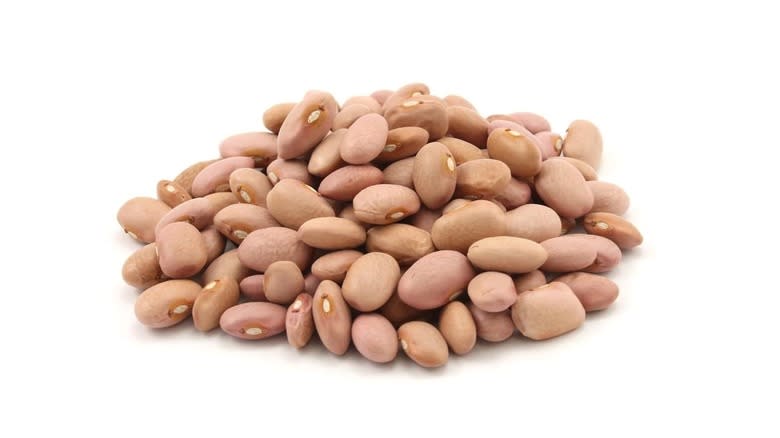
While different varieties of apples have names that range from the effusive Ambrosia to the mysterious Northern Spy, beans tend to have pretty plebeian names. Apart from the organ-shaped kidney beans, many types of beans are simply named for their color: green, red, black, pinto (Spanish for "painted"), cranberry, and, yes, pink. To answer the question posed above, pink beans, no surprise here, are beans that are pink.
Pink beans (Phaseolus vulgaris) are pretty popular in Puerto Rico and throughout the Caribbean and are also used in Mexican and Southwestern cuisine. In Spanish-speaking countries they go by the name of habichuelas rosadas, which quite literally means "pink beans," so apparently other languages are no more creative in their bean-naming conventions than English. They sometimes go by the nickname of "pinquitos," however, which is both shorter and cuter. It's actually a "Spanglish" mashup of the word pink with the diminutive ending "ito." It's somewhat analogous to calling the beans 'lil pinkies," which would also be a cute nickname if anyone wants to adopt it.
Read more: 7 Nuts You Should Be Eating And 7 You Shouldn't
What Are Pink Beans?
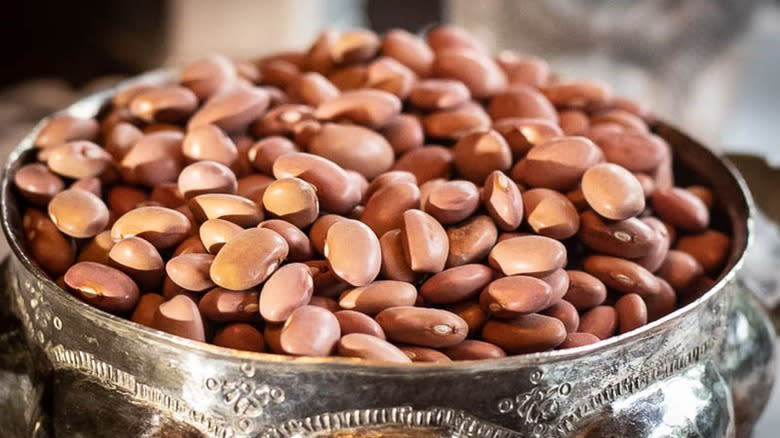
Pink beans belong to the family Fabaceae, as do many other beans and legumes including peas and lentils along with certain herbs (fenugreek), flowers (lupine), tree (redbud), and invasive weeds (kudzu). It's a big family, and a very diverse one, and we imagine that Thanksgiving at the Fabaceae's is quite an experience. Lil' pinkies, as we already disclosed, are pink as per their name, although they're actually more of a pinkish-brown than a bright Barbie bubblegum hue. Their shape somehat resembles that of the kidney beans, which is no surprise seeing as how the two varieties are related. Size-wise, pink beans are small to medium, typically measuring between ⅜ and ½ inch long.
Pink beans, or something very much like them, may have first been cultivated in Peru some 7000 years ago from this cradle of beandom their progeny traveled northwards throughout South and Central America and on into Mexico. They were brought to Europe by Spaniards returning from the New (to them) World and at some point in the 19th century (or perhaps earlier, plants being no respecters of borders) they found their way across the Rio Grande and into the southwestern United States and California.
What Are Some Varieties Of Pink Beans?
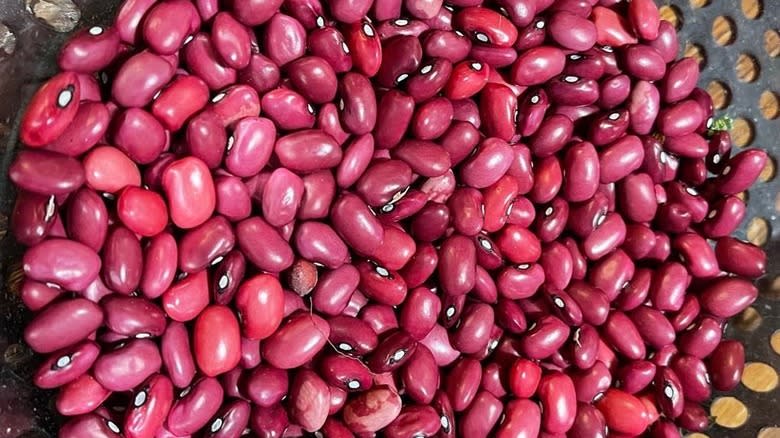
Pink beans come in several different varieties. One type of pink bean, the O'odham by name, shares a name and a region with certain indigenous peoples of the Sonoran desert. While the beans grow wild along the Arizona/Mexico border, they were first cultivated around 300 years ago. These beans, as might be expected of a desert plant, can take a fair amount of heat and dry weather, but they ripen in late summer when the rain comes at last. A more recent variety of pink beans known as Sedona was bred to be disease-resistant. Although its name is that of Arizona's new age capital, the bean itself doesn't seem to have mystical properties. In fact, it was actually developed at the very down-to-earth (and not at all Arizonan) Michigan Agricultural Experiment Station and was made public in 2005.
Perhaps the best known of the pink beans is the Santa Maria pinquito which plays such an important part in that California city's namesake style of barbecue. That state's central coast region is said to be the only place where this bean variety is grown for commercial use. Another California pink bean, while less popular these days, has a literary pedigree: The pink beans mentioned by John Steinbeck in his 1935 novel "Tortilla Flat" have been identified by some bean experts as King City pinks. These beans are larger and more robust than the Santa Maria kind but are said to be rich and flavorful.
What Do Pink Beans Taste Like?
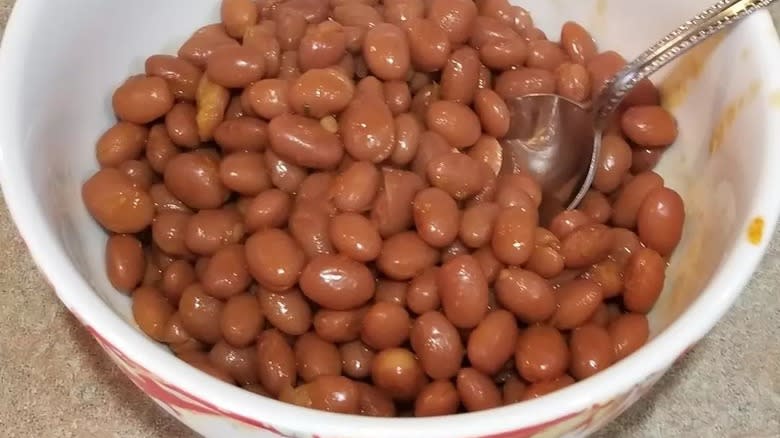
Pink beans have a flavor and a texture that is not dissimilar to other types of dried beans. When they are in their dried state, they are practically inedible and are more reminiscent of little pink pebbles than food. After a good long soak and a slightly shorter simmer, they soften up and develop a creamy smoothness that makes them well-suited for use in such dishes as refried beans (we'll explore this topic a bit more in the next slide).
While pink beans can, in many cases, be used interchangeably with kidney and pinto beans (both of which bean types are also classified as Phaseolus vulgaris), there is some subtle difference in flavor. A true bean buff may find that they taste a little bit sweet while still pretty meaty, and their relatively thin skin imparts a certain delicacy, as well. As heirloom bean farmer Steve Sando once told the Los Angeles Times, he feels pink beans are "10 times better" than their kidney bean cousins and he extols the "distinctive, delicious bean broth" you get when you boil them up in a pot of water.
How To Cook With Pink Beans
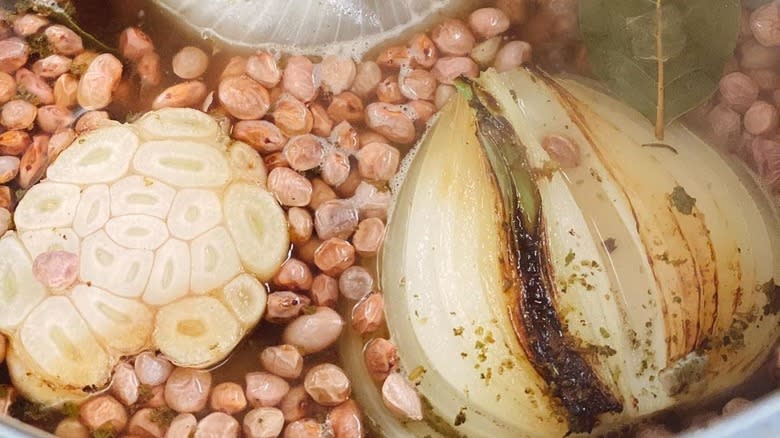
Assuming that you are starting with the freshest of pink beans, you'll first need to pick them and then dry them out before you cook them. If you're buying them in bags from the store, you can skip this step and start with an overnight soak before boiling them for an hour or more to tenderize them. If your pink beans are of the canned variety, all you need to do is wield your trusty can opener and you'll be all set to cook with gas (or electricity, or microwave radiation, as the case may be).
Steve Sando, the aforementioned bean farmer and LA Times informant, has said that pink beans are best if they're cooked in a very plain and simple style with nothing more than garlic and onion for flavoring. Adding anything else that might overshadow them, he feels, would be a waste of their flavor. Countless others disagree, however, preferring to add ingredients such as tomatoes, peppers, cilantro, bacon, and bits of beef to the mix. Pink beans are often served with rice but all on their own they're a must-have side dish for the tri-tip Santa Maria steak that's the centerpiece of the Central Coast's regional style of barbecue.
Where To Buy Pink Beans
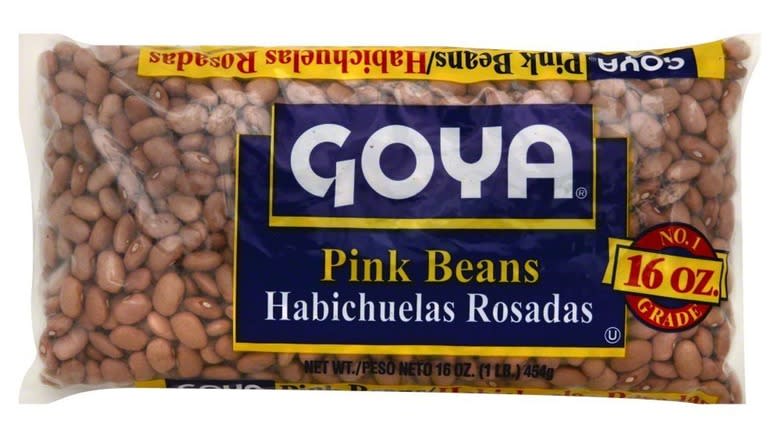
Pink beans, while perhaps not quite as common in most parts of the country as kidney or black beans, can still be purchased in standard supermarkets in both dried and canned form. Some of the food brands that produce pink beans include Goya, Iberia, and La Preferida. As canned and dried beans are shelf-stable, neither item is seasonal, and both should be available year-round. Look for the dried kind in the rice and beans aisle and the canned kind with the other canned beans since unless your local grocer has some unconventional way of arranging its foodstuffs, this is most likely where you will find them.
If you're unable to purchase pink beans at any supermarkets in your area, you may find them online, as well. Nuts.com sells the dried kind in 1 and 5-pound bags, while Amazon not only offers both dried and canned pink beans but also has ready-to-eat Puerto Rican-style pink beans in sofrito. If you are particularly picky about your pink beans' provenance, you can look to specialty suppliers such as Rancho Gordo where you may obtain the Steinbeck-famous King City variety. Susie Q's, a retailer specializing in all things Santa Maria-style, of course, offers Santa Maria pinquito beans for sale. The website also features a special pinquito seasoning mix of chiles, onions, garlic, and other spices as well as kits that combine both beans and seasoning.
Nutritional Information About Pink Beans
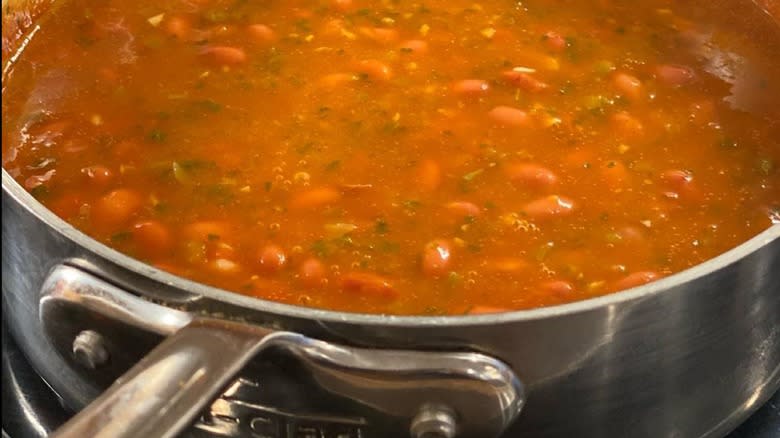
Pink beans, like many a legume, are a good source of protein and fiber, with a one-cup serving containing between 10 and 15 grams of the former and about the same amount if it's the latter. That same serving can also range from about 150 to 250 calories depending on whether the beans are canned or cooked from dried beans. Pink beans are also naturally fat-free and have just trace amounts of sugar, although canned beans or beans cooked in salted water may have a fair amount of sodium — between 400 and 750 milligrams per serving, give or take, depending on how much salt is used and, if canned, what brand of beans you buy.
Pink beans do have their downside, though, most notoriously the fact that they, along with other types of beans, have a propensity for producing flatulence. On a more serious note, pink beans, as well as other beans categorized as Phaseolus vulgaris, are also considered to have moderate potential for toxicity. If pink beans are eaten when not fully cooked, food poisoning may result, in which case it's not just gas you'll have to worry about but eruptions of a more solid (or liquid) nature from either or both ends. While the unfortunate event should only last for a few hours or so, still, this kind of thing may well inhibit your ability to enjoy beans ever after.
Read the original article on Mashed.

